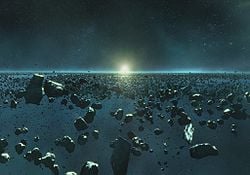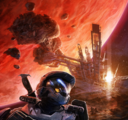Asteroid: Difference between revisions
From Halopedia, the Halo wiki
No edit summary |
No edit summary |
||
| Line 1: | Line 1: | ||
{{Era|UNSC|HCW}} | {{Era|UNSC|HCW}} | ||
[[File:Epsiloneridani.jpg|thumb|250px|One of [[Epsilon Eridani system|Epsilon Eridani]]'s two asteroid belts.]] | [[File:Epsiloneridani.jpg|thumb|250px|One of [[Epsilon Eridani system|Epsilon Eridani]]'s two asteroid belts.]] | ||
An '''asteroid''' is a naturally occurring solid object that is smaller than a planet. Asteroids are often found in asteroid belts orbiting a star, or, in some cases, trailing a planet in a [[ | An '''asteroid''' is a naturally occurring solid object that is smaller than a planet. Asteroids are often found in asteroid belts orbiting a star, or, in some cases, trailing a planet in a [[Lagrange point|Lagrangian point]].<ref>'''[[Halo: The Cole Protocol]]''', ''page 166''</ref> | ||
Asteroids can also be used as habitats or [[military base]]s, with [[artificial gravity]] often provided by rotation. Notable examples of this were the [[Insurrectionist]] hideouts [[Eridanus Secundus]] and [[the Rubble]], the latter being a remarkable feat of engineering, composed of hundreds of asteroids with independent propulsion systems connected by flexible docking tubes.<ref>'''Halo: The Cole Protocol''', ''page 62''</ref> [[Covenant Empire|The Covenant]] used asteroids such as [[K7-49]] as refineries and shipyards.<ref name="GoO">'''[[Halo: Ghosts of Onyx]]''', ''pages 83-84''</ref> | Asteroids can also be used as habitats or [[military base]]s, with [[artificial gravity]] often provided by rotation. Notable examples of this were the [[Insurrectionist]] hideouts [[Eridanus Secundus]] and [[the Rubble]], the latter being a remarkable feat of engineering, composed of hundreds of asteroids with independent propulsion systems connected by flexible docking tubes.<ref>'''Halo: The Cole Protocol''', ''page 62''</ref> [[Covenant Empire|The Covenant]] used asteroids such as [[K7-49]] as refineries and shipyards.<ref name="GoO">'''[[Halo: Ghosts of Onyx]]''', ''pages 83-84''</ref> | ||
In a skirmish following the [[Callisto Incident]] in [[2494]], an asteroid was used by the | In a skirmish following the [[Callisto Incident]] in [[2494]], an asteroid was used by the Insurrectionists to gain a tactical advantage in battle, using a outward-facing [[nuclear weapon|nuclear explosive device]] buried in an asteroid, greatly increasing the destructive power of the weapon in vacuum environment by providing enough reactive mass to destroy one UNSC ship and cripple two.<ref>'''Halo: Evolutions''', "The Impossible Life and the Possible Death of Preston J. Cole", ''page 440''</ref> | ||
==Known asteroids or asteroid belts== | ==Known asteroids or asteroid belts== | ||
| Line 18: | Line 18: | ||
==Trivia== | ==Trivia== | ||
*The depictions of asteroid belts in ''[[Halo: Reach]]'' and ''[[Halo: Fall of Reach - Boot Camp]]'' follow a common popular culture depiction of an asteroid belt, where the asteroids float in an extremely dense field within visible distance of each other. In real life, asteroids are spaced millions of kilometers apart and it would be highly unlikely to even see one when passing through an asteroid field. | *The depictions of asteroid belts in ''[[Halo: Reach]]'' and ''[[Halo: Fall of Reach - Boot Camp]]'' follow a common popular culture depiction of an asteroid belt, where the asteroids float in an extremely dense field within visible distance of each other. In real life, asteroids are spaced millions of kilometers apart and it would be highly unlikely to even see one when passing through an asteroid field. | ||
==Gallery== | |||
<gallery> | |||
File:FoR Eridanus Secundus ext.png|Eridanus Secundus and the Eridanus asteroid belt. | |||
File:The Rubble.png|A view of the Rubble. | |||
</gallery> | |||
==Sources== | ==Sources== | ||
<references/> | <references/> | ||
[[Category:Asteroids]] | [[Category:Asteroids]] | ||
Revision as of 08:14, September 30, 2011

An asteroid is a naturally occurring solid object that is smaller than a planet. Asteroids are often found in asteroid belts orbiting a star, or, in some cases, trailing a planet in a Lagrangian point.[1]
Asteroids can also be used as habitats or military bases, with artificial gravity often provided by rotation. Notable examples of this were the Insurrectionist hideouts Eridanus Secundus and the Rubble, the latter being a remarkable feat of engineering, composed of hundreds of asteroids with independent propulsion systems connected by flexible docking tubes.[2] The Covenant used asteroids such as K7-49 as refineries and shipyards.[3]
In a skirmish following the Callisto Incident in 2494, an asteroid was used by the Insurrectionists to gain a tactical advantage in battle, using a outward-facing nuclear explosive device buried in an asteroid, greatly increasing the destructive power of the weapon in vacuum environment by providing enough reactive mass to destroy one UNSC ship and cripple two.[4]
Known asteroids or asteroid belts
- Bonanza Asteroid Belt
- Eridanus asteroid belt
- Indra Asteroid Cluster
- Origami Asteroid Field
- The Rubble
- K7-49
Trivia
- The depictions of asteroid belts in Halo: Reach and Halo: Fall of Reach - Boot Camp follow a common popular culture depiction of an asteroid belt, where the asteroids float in an extremely dense field within visible distance of each other. In real life, asteroids are spaced millions of kilometers apart and it would be highly unlikely to even see one when passing through an asteroid field.
Gallery
Sources
- ^ Halo: The Cole Protocol, page 166
- ^ Halo: The Cole Protocol, page 62
- ^ Halo: Ghosts of Onyx, pages 83-84
- ^ Halo: Evolutions, "The Impossible Life and the Possible Death of Preston J. Cole", page 440

